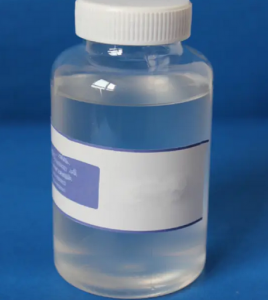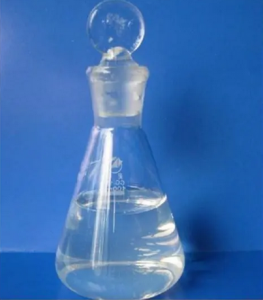
-
Trimethylethoxysilane CAS :1825-62-3
Name: Ethoxytrimethylsilane CAS number: 1825-62-3 Molecular formula: C5H14OSi Molecular weight: 118.25 EINECS number: 217-370-6 Mol file: 1825-62-3.molTags : Trimethylethoxysilane TMES CAS :1825-62-3 Trimethylethoxysilane from factory factory direct sale Trimethylethoxysilane capping agent
-
Trimethylchlorosilane (TMCS) CAS :75-77-4
Name: Chlorotrimethylsilane CAS number: 75-77-4 Molecular formula: C3H9ClSi Molecular weight: 108.64 EINECS number: 200-900-5 Mol file: 75-77-4.molTags : Trimethylchlorosilane CAS :75-77-4 TMCS Trimethylchlorosilane from factory Cost price Trimethylchlorosilane High purity Trimethylchlorosilane
-
Hexamethyldisilylurea CAS:18297-63-7 (BSU )
Name: 1,3-Bis (trimethylsilyl) urea CAS number: 18297-63-7 Molecular formula: C7H20N2OSi2 Molecular weight: 204.42 EINECS number: 242-177-9 Mol file: 18297-63-7.molTags : BSU CAS:18297-63-7 Hexamethyldisilylurea High pruity Hexamethyldisilylurea Cost price Hexamethyldisilylurea Hexamethyldisilylurea from factory
-
Sodiumhexamethyldisilazane CAS :1070-89-9 (CAS :1070-89-9)
Name: Sodium bis (trimethylsilyl) amide CAS number: 1070-89-9 Molecular formula: C6H18NNaSi2 Molecular weight: 183.37 EINECS number: 213 983-8 Mol file: 1070-89-9.molTags : Sodiumhexamethyldisilazane NAHMDZ CAS :1070-89-9 Cost price Sodiumhexamethyldisilazane High quality Sodiumhexamethyldisilazane Sodiumhexamethyldisilazane from Factory
-
Tetramethyldisiloxane (TMDSO) CAS :3277-26-7
Name: 1,1,3,3-Tetramethyldisiloxane CAS number: 3277-26-7 Molecular formula: C4H14OSi2 Molecular weight: 134.32 EINECS number: 221-906-4 Mol file: 3277-26-7.molTags : TMDSO Tetramethyldisiloxane CAS :3277-26-7 factory price Tetramethyldisiloxane raw material Tetramethyldisiloxane High quality Tetramethyldisiloxane
-
Tetramethyldivinyldisilazane VMN CAS:7691-02-3
Name: 1,1,3,3-TETRAMETHYL-1,3-DIVINYLDISILAZANE CAS number: 7691-02-3 Molecular formula: C8H19NSi2 Molecular weight: 185.41 EINECS number: 231-701-1 Mol file: 7691-02-3.molTags : Tetramethyldivinyldisilazane low price Tetramethyldivinyldisilazane good price Tetramethyldivinyldisilazane factory price Tetramethyldivinyldisilazane VMN CAS:7691-02-3
-
Dimethylvinlychlorosilane (DMV )CAS :1719-58-0
Name: CHLORODIMETHYLPINYLSILANE CAS number: 1719-58-0 Molecular formula: C4H9ClSi Molecular weight: 120.65 EINECS number: 217-007-1 Mol file: 1719-58-0.molTags : CAS :1719-58-0 DMV Dimethylvinlychlorosilane good price Dimethylvinlychlorosilane factory price Dimethylvinlychlorosilane good quality Dimethylvinlychlorosilane
-
Dimethylvinylethoxysilane (DMEOV) CAS :5356-83-2
Name: Ethoxydimethylvinylsilane CAS number: 5356-83-2 Molecular formula: C6H14OSi Molecular weight: 130.26 EINECS number: 226-341-7 Mol file: 5356-83-2.mol -
Vinyltrimethylsilane (VTMS) CAS : 754-05-2
Name: Vinyltrimethylsilane CAS number: 754-05-2 Molecular formula: C5H12Si Molecular weight: 100.23 EINECS number: 212-042-9 Mol file: 754-05-2.molTags : good quality Vinyltrimethylsilane good price Vinyltrimethylsilane Vinyltrimethylsilane VTMS CAS : 754-05-2 Vinyltrimethylsilane from factory
-
Methylvinyldichlorosilane CAS : 124-70-9 (VDCS )
Name: Dichroromethylvinylsilane CAS number: 124-70-9 Molecular formula: C3H6Cl2Si Molecular weight: 141.07 EINECS number: 204-710-3 Mol file: 124-70-9.molTags : good quality Methylvinyldichlorosilane good price Methylvinyldichlorosilane factory price Methylvinyldichlorosilane CAS : 124-70-9 VDCS Methylvinyldichlorosilane
-
sodium bicarbonate CAS:144-55-8
Name: Sodium bicarbonate CAS No.: 144-55-8 Appearance: White powder or opaque monoclinic system fine crystals Molecular formula: CHNaO3 Molecular Weight: 84.01 Melting point:>300 °C(lit.) PACKAGE:25KG/BAGTags : CAS:144-55-8 sodium bicarbonate HS CODE:2836300000 CHNaO3 sodium bicarbonate low price
-
ASPIRIN-DL-LYSINE
Name: ASPIRIN-DL-LYSINE CAS No.: 65952-06-1 Appearance: White crystalline or crystalline powder Molecular formula: C15H22N2O6 Molecular Weight: 326.35 Standards: CP2020 PACKAGE:8KGS/10KGS/Tin
 call us :
call us :  send a message :
send a message : 























 online service
online service +8613866722531
+8613866722531

 +8613866722531
+8613866722531